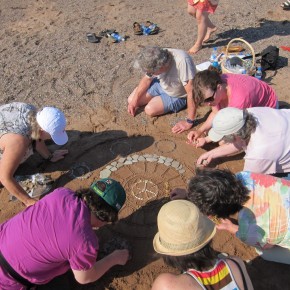Moncton-based photographer and filmmaker Jaret Belliveau’s photographic work addresses illness and loss. Arguably, Belliveau is best known for his series Dominion Street (2003-2008), which began as a visual investigation into family dynamics and the hegemonic balances of power that maintain them. However, ten months into the project, Belliveau’s mother was diagnosed with stomach cancer. Soon after, the disease spread throughout the rest of her body, in time taking her life. Upon the recent staging of Dominion Street at Fredericton’s Beaverbrook Gallery (April 26-June 10, 2012), writer Matthew Ryan Smith and Belliveau engaged in a conversation, exploring Belliveau’s autobiographical approach, the viewer’s relationship to his work and how the series weighs on the artist now.
MATTHEW RYAN SMITH: I would like to begin with a rather straightforward question: What was the impulse behind pointing your camera towards your family?
JARET BELLIVEAU: I wanted to know the stories of their lives more intimately in the hope of learning more about myself. The need to photograph my family came from the natural desire to understand them at a deeper level. To know their story would also reveal my own.
SMITH: I’m also interested in your family’s immediate reactions to having their photos taken during intimate moments in their lives.
BELLIVEAU: I would say that my family almost didn’t react to me photographing them. My documentary practice is one of patience. I would often fade into the background to carefully watch what would unfold. This approach helped to create the intimate moments within these images. Somehow I was able to find a still point in my mind to focus with.
SMITH: Your pictures appear strikingly reminiscent of Richard Billingham’s early work. Billingham was once quoted as saying, “It’s not my intention to shock, to offend, sensationalize, be political or whatever; only to make work that is as spiritually meaningful as I can make it—whatever the medium.” How close is your practice to his philosophy?
BELLIVEAU: I would say that I share his sentiment of not wanting to shock or offend, but I have not really kept spirituality in mind when I take photographs. I am more concerned with having a genuine connection with my subjects, finding descriptive moments and being conscious of the decisive moments in front of me.
SMITH: The pictures of Billingham’s father Ray in his bed are a central trope in the photobook Ray’s a Laugh (1994). The bed features prominently in your work as well. The first image in Dominion Street is of your father sleeping in his bed. The last image in the series is of his dirty, empty bed. What is the relationship between the photographer and his father’s place of rest?
BELLIVEAU: The idea for the photograph of my father sleeping came from memories of my childhood. My father was usually away all week working and would spend a lot of the weekend catching up on sleep. When I first started to photograph my family, I was working from a narrative based both on my memories as well as from the things I was learning.
The photograph of my father’s dirty bed, Dad’s Bed, from the end of the series, represents to me the loss of my mother. Everywhere I looked within the home I was reminded of my mother and I would feel a deep sadness knowing that without her everything was different. When she did die, everyone mourned differently and my brother Trevorr became uncontrollable. Trevorr’s frustrations, along with my other brother David’s rebellious spirit, were captured by the destruction that followed. The place started speaking to me much more than any portrait ever could.
SMITH: Specifically, what influenced pictures such as these?
BELLIVEAU: Dominion Street was influenced mostly by the work of Larry Sultan. The first time I saw his book Pictures From Home (1982-1992), I became transfixed by his ability to take mundane moments and make them deeply descriptive. At the time I began photographing Dominion Street I was still in my third year at NSCAD, so evidently I was also influenced by a long list of photographers including Henri Cartier-Bresson, Susan Meiselas, Nan Goldin, Diane Arbus, Garry Winogrand and many others including the professors I worked with such as Gary Wilson, Susan McEachern, Alvin Comiter and Ruth Kaplan.
SMITH: Which image from the Dominion Street series is the most poignant for you?
BELLIVEAU: One image that stands out for me is David’s Last Visit. I remember composing this image accepting not only my mother’s death but also my father who sits with his head down across from my mother. The time I spent with my mother in palliative care haunts me but there is one moment that sticks out the most. As my mother lay in her bed filled with morphine, she turned to me with her eyes hazy and begged me to help her leave the hospital. I felt completely helpless. I remember having to fight back tears as I reassured her that everything was going to be alright, as my mind dreamt simultaneously of picking up her frail body and walking her out of there.
SMITH: The image that resonates most for me and for others I have spoken to is Untitled (Telling Jokes), 2004. In the photograph your mother clutches an ice cream container while laughing at (or with) someone behind the camera. For me, it’s both beautiful and tragic, joyous and haunting. What does this image mean for you?
BELLIVEAU: Originally I had not included this image in Dominion Street. Several years after my mother’s death, I was editing the work and came across this image. I began to reflect on my mother’s sense of humour and joie de vivre. As difficult as this work was for me to make, I also have fond memories of how our relationship grew into something much deeper during this time. Photography was, in a sense, my excuse to be there. The camera became a vehicle for me to guarantee that my mother did not suffer in silence.
SMITH: Do you see your work as trauma-related art and have you thought about the viewer’s relation to the work in this way?
BELLIVEAU: I have thought of the work in that way, but I also have accepted that the work is what it is: a tragic tale of a middle class family. I often find myself talking with people through their pain but in the end, I feel like there is some form of closure with the work. Most of us suffer alone, and this type of experience perhaps can help remind people that they are not alone.
SMITH: You were once quoted as saying that with the Dominion Street images, you wanted “to be compassionate to my father losing a wife. Or to my grandmother watching her daughter die.” How important is compassion to autobiographical photography?
BELLIVEAU: I believe that without compassion, one cannot be a good documentary photographer … I was as much of a witness to this tragedy as I was a participant. To make this work, I needed to separate my own experience to even have a chance to capture someone else’s.
SMITH: There is a fine line between exploitation and examination. Photographers like Diane Arbus were once criticized for being “outsiders” looking in while others like Nan Goldin were supported because they were on the “inside” looking out. What can those on the “inside” understand and communicate that those on the “outside” cannot?
BELLIVEAU: I think the main difference is what motivates someone who is an “insider.” When it is your personal reality that you are trying to describe, I feel that you are more likely to capture very intimate moments from a place of compassion, of empathy. One thing that I see in highly personal work is the photographer’s ability to not only expose their subjects but also their own private world.
SMITH: Was there ever a time you felt like you were misusing your mother’s illness for art’s sake?
BELLIVEAU: At one point during my mother’s illness I did feel that I was losing a connection with her, so I stopped photographing for over a month. Photographing her allowed me to spend countless days at her side. Art became the vehicle to allow me this precious time. Also, I would often only take twelve photographs a day, if that, so my family had lots of time with me and not the camera.
SMITH: After the passing of your mother, you and your younger brother David took a cross-country drive across Canada. You candidly documented this journey. Why was it important to leave Moncton at this time, and what were you looking to accomplish with these photographs?
BELLIVEAU: With the death of my mother, I knew deep down that my family dynamic would never be the same. I came up with the idea to take this adventure with David in an attempt to see if the road could give us a place to grieve. With David being so young, I thought it would be best for him to get away. Artistically, the work also forced me to find a new direction. The photographs taken during the trip were set up by me in reference to the vernacular images taken on most family vacations. The only difference was that I did not tell David how to stand or act in any way. I wanted to give him a space to express himself. The road trip was a bit of a romantic thought, which often bumped into the reality of travelling with a brother who was both angry and broken.
SMITH: The ability to capture “the perfect moment” has always fascinated me. Awareness of it seems to be the difference between good photographers and the rest. I think you sense that moment. What is it exactly and how do you locate it?
BELLIVEAU: The “moment” you speak of is exactly that: a feeling, an affect. It is as important, if not more important, than the composition within the frame. As I take photographs and immerge myself in a situation, I often get a tingling from visual cues which tells me when to release the shutter. The feeling comes from what I notice to be a balance of the visual cues within the frame, such as the alignment of multiple planes of an image, the lighting and a hindsight. The continuous recognition of this “moment” only became evident well into my time at NSCAD.
SMITH: What does Dominion Street mean to you now?
BELLIVEAU: Dominion Street continues to change for me. In the beginning, it was a place to engage with while drawing inspiration and understanding. As my mother went into the hospital, it was a place to deal and make sense of what I was seeing. Then began a time of mourning and the painful discovery of what was to become my new family dynamic. The work has often been a weight around me, a reminder of a specific time that I was trying to compartmentalize, to understand.


















Pingback: The Participating Witness | L&E Private Art Collection